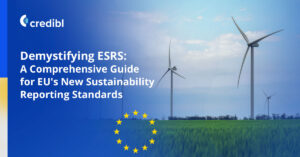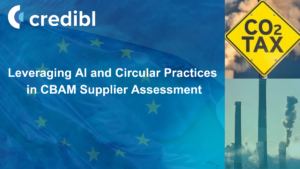Introduction
In a landmark move towards global climate action, the European Union has launched the Carbon Border Adjustment Mechanism (CBAM), a transformative policy reshaping international trade and driving sustainable business practices.
This blog explores the CBAM’s mechanisms, impacts, and broader implications for global trade and industry, especially carbon-intensive sectors.
Understanding the EU CBAM
The EU’s CBAM aims to reduce greenhouse gas emissions and prevent carbon leakage—the shifting of production to countries with less stringent climate policies. From 2026, it will require the purchase of CBAM certificates, signifying a financial component based on the carbon content of imports.
Essentials of EU CBAM
- Combatting Carbon Leakage: Targets reducing greenhouse gas emissions by imposing costs on carbon-heavy imports from 2026.
- Extension of ETS: Complements the EU Emissions Trading System by applying similar environmental costs to external producers.
- Aligned with “Fit for 55” Goals: Contributes to the EU’s objective to reduce emissions by 55% from 1990 levels by 2030.
Carbon Border Adjustment Mechanism (CBAM) Timeline:
CBAM: Driving Sustainable Business Practices
With the urgency of climate change demanding immediate action, the EU’s CBAM emerges as a powerful tool in the fight for a greener future. By incentivizing carbon-neutral practices and reshaping trade dynamics, CBAM holds the potential to significantly reduce global emissions and pave the path towards a sustainable global economy.
- Incentivizing Sustainable Production: Encouraging businesses, both within and outside the EU to minimize their carbon footprint, aligning with the EU’s carbon reduction goals.
- Reshaping Trade Dynamics: Influencing international trade, potentially leading to supply chain and trade partnership reforms towards more carbon-efficient practices.
- Enforcing Supply Chain Transparency: Mandating a detailed analysis of supply chains to identify and address carbon emissions, using CBAM certificates as a financial tool to track greenhouse gas footprints.
Exemptions and Adjustments in CBAM
The CBAM framework incorporates provisions for exemptions and adjustments, adding a layer of fairness and flexibility to the mechanism. Importers can claim reduced fees based on the emissions intensity of their products, acknowledging efforts towards lower carbon footprints.
- Countries within the EU ETS: Imports from countries in the EU ETS, including the EEA, are exempt.
- Countries with Linked ETS: Countries with a domestic ETS linked to the EU ETS, such as Switzerland, are also exempt.
- Special Cases: Low-value shipments and goods intended for military use are not subject to CBAM.
Impact on Global Trade and Industry
CBAM’s introduction will fundamentally reshape global trade. High-carbon producers outside the EU will find themselves less competitive in the EU market, leading to higher costs for EU end users and potentially shifting trade partnerships. For example, considering Spain’s steel imports, CBAM could impose tariffs of approximately 1 billion euros annually by 2034. While initially targeting the most carbon-intensive sectors, CBAM’s scope is expected to expand, influencing multinational corporations to revise offshoring and sourcing strategies. Initially, the mechanism will apply to imports following industries.
- Iron and Steel: A major industrial sector with significant carbon emissions.
- Cement: Known for its high carbon footprint, particularly in production processes.
- Fertilizers: Their production is energy-intensive and emits a considerable amount of greenhouse gases.
- Aluminium: Producing aluminium is energy-intensive, contributing to high carbon emissions.
- Hydrogen: The focus on hydrogen reflects the EU’s interest in cleaner energy sources.
- Electricity: Addressing the carbon content of imported electricity.
These sectors are chosen due to their high carbon emissions and vulnerability to shifts in production to regions with less stringent climate policies. As CBAM fully phases in, it is expected to cover over 50% of the emissions in sectors governed by the EU ETS. This strategic focus on key industries underscores CBAM’s role in driving substantial climate action and aligning international trade with the EU’s environmental objectives.
CBAM and Environmental Goals
CBAM’s broader strategic impact lies in its potential to shift the behavior of importers and exporters towards decarbonization. For industries like steel, the choice between paying new levies and investing in greener technologies becomes critical.
- Decarbonization Drive: Encourages industries to opt for greener technologies over new levies.
- Broad Emission Coverage: Expected to significantly cover emissions, pressuring exporters to the EU to lower their carbon emissions.
The implementation of an all-encompassing CBAM could lead to significant emissions coverage (up to 3871 MtCO2). This would create an ‘upstream pressure’ on exporters to the EU, motivating them to reduce emissions to remain competitive. However, without export rebates, this could also lead to ‘downstream pressure’ and consumption leakage, favoring producers not subjected to a carbon price.
Credibl ESG’s Role in Facilitating CBAM Compliance
In this evolving regulatory landscape, Credibl ESG emerges as a vital partner for businesses navigating CBAM compliance. It aligns with CBAM’s foundational framework, and objectives, particularly in preventing carbon leakage and equalizing the carbon costs of imported and EU-produced goods. The salient features and services offered by Credibl are;
- Compliance Facilitation: Credibl ESG provides vital tools for businesses to comply with CBAM regulations.
- Data Management and Reporting: Assists in accurately tracking and reporting carbon emissions.
- Strategic Advisory: Offers expert guidance on CBAM’s intricacies, especially for high-emission industries.
- Training and Awareness: Provides educational resources to help businesses understand and navigate the complexities of CBAM.
- Sustainability Integration: Aids in aligning business practices with CBAM’s sustainability goals, promoting long-term environmental strategies.
- Customized Solutions: Tailors services to individual business needs, ensuring effective adaptation to CBAM requirements.
Conclusion
The CBAM represents a pivotal step in aligning global trade with environmental sustainability. By incentivizing greener production practices and reshaping international trade dynamics, it serves as a powerful tool in the EU’s arsenal to combat climate change. As businesses adapt to this new reality, the role of solutions like Credibl ESG becomes increasingly vital, offering the tools and guidance needed for effective adaptation and compliance. The impact of CBAM, both in terms of fostering sustainable business practices and in promoting global climate action, cannot be overstated. It’s a testament to the EU’s commitment to a greener future and a call to action for businesses worldwide to prioritize sustainability in their operations.
For guidance on incorporating the Carbon Border Adjustment Mechanism (CBAM) into your business strategy, get in touch with our ESG experts.








